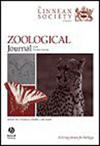Taxonomic revision of Chilean Liogenys (Coleoptera: Melolonthidae) and molecular assessment of a species complex
IF 2.8
2区 生物学
Q1 ZOOLOGY
引用次数: 0
Abstract
Liogenys is a neotropical genus widely distributed in South America and characterized by rhizophagous feeding habits. Taxonomy survey of Liogenys from Chile revealed a species complex consisting of L. palpalis, L. obesula and an undescribed morphotype. Morphological data alone are not sufficient to distinguish between them. The three-species hypothesis was tested using phylogenetic and preliminary phylogeographic analyses, as well as unilocus delimitation methods using mitochondrial (COI) and nuclear (ITS2) markers. The tree-based PTP method based on ITS2 considers both L. obesula and the undescribed morphotype to be variants of L. palpalis, a single, polymorphic species. Haplotypes from 12 localities along central Chile revealed four genetically structured populations, with statistical variance (54.34%) only within them. Isolated populations occur in Southern Santiagan Region and coastal desert. There are eight species of Liogenys in Chile. Diagnoses are provided for five species. Liogenys elguetai sp. nov. is described. Five synonyms are proposed for three species. Liogenys pubisternis, a new synonym of L. palpalis, is transferred from Diplotaxis. Lectotypes are provided for four names (L. castaneus, L. grandis, L. pubisternis, and Melolontha palpalis). Liogenys boliviensis is recorded for the first time from Chile and Peru, extending the distribution of Liogenys to northernmost Chile.智利褐飞蛾(鞘翅目:褐飞蛾科)的分类修订及一种复合体的分子鉴定
Liogenys是一个广泛分布于南美洲的新热带属,以食根性食性为特征。对智利Liogenys的分类调查发现了一个由palpalis L.、obesula L.和一个未描述的形态组成的种复合体。形态学数据本身不足以区分它们。通过系统发育和初步系统地理分析,以及使用线粒体(COI)和核(ITS2)标记的单点划界方法,对三种假设进行了验证。基于ITS2的树型PTP方法认为,L. obesula和未描述的形态型都是L. palpalis的变体,这是一个单一的多态物种。从智利中部12个地区的单倍型中发现了4个遗传结构群体,仅在群体内部存在统计学差异(54.34%)。孤立的种群出现在南圣地亚哥地区和沿海沙漠。智利有八种lioggenys。诊断提供了五个物种。描述了龙舌兰(lioggenys elguetai sp. 11)。对三个物种提出了五个同义词。由Diplotaxis引申而来的Liogenys pubbisternis,是palpalis的新同义词。提供了四个名称(L. castaneus, L. grandis, L. pubbisternis和Melolontha palpalis)的选型。首次在智利和秘鲁发现Liogenys boliviensis,将Liogenys的分布范围扩大到智利最北部。
本文章由计算机程序翻译,如有差异,请以英文原文为准。
求助全文
约1分钟内获得全文
求助全文
来源期刊
CiteScore
6.50
自引率
10.70%
发文量
116
审稿时长
6-12 weeks
期刊介绍:
The Zoological Journal of the Linnean Society publishes papers on systematic and evolutionary zoology and comparative, functional and other studies where relevant to these areas. Studies of extinct as well as living animals are included. Reviews are also published; these may be invited by the Editorial Board, but uninvited reviews may also be considered. The Zoological Journal also has a wide circulation amongst zoologists and although narrowly specialized papers are not excluded, potential authors should bear that readership in mind.

 求助内容:
求助内容: 应助结果提醒方式:
应助结果提醒方式:


